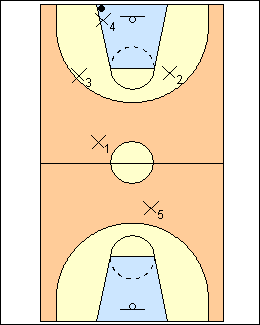 | 1 "1 Press" ("2 Press" is the 2-2-1) Point X4 is likely the most athletic of the two big men. He prevents the quick long inbounds pass, or a pass to any attacker on the right (wide) side of the court. X3 is the "tight wing" (on the side where the ball is usually taken out of bounds), X2 is the "wide wing". The wide wing denies the ball to any attacker on his side of the court, while the tight wing denies or forces the ballhandler to the deep corner on the tight side. X1 is the "monster". Since the point guard is already back for defensive transition on missed shots, he is likely the best choice. The monster denies any inbounds pass near or farther down the floor on tight side. X5 is the safety (some coaches will switch X3 and X5). He denies any long pass on the wide side, and is the first defender back to protect the basket after the inbounds pass. |
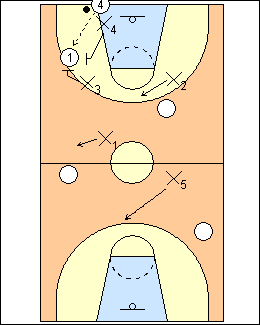 | 2 The inbounds pass is trapped only on the tight side (not the wide side), by point X4 and tight wing X3. The tight wing never gives up the sideline dribble, and the point never gives up the dribble split (no lines, no split). They will sprint to get to ball level if the trap breaks down. Wide wing X2 and monster X1 split the difference in spacing among the three most logical passing avenues - the ballside midcourt area, the middle area near the top of the circle, and the area below the basket. Since the middle of the press is the most vulnerable area, it must be defended more heavily. The monster cheats towards any potential pass receiver near the ballside midcourt area, while the wide wing attempts to stop any pass to the middle of the court. |
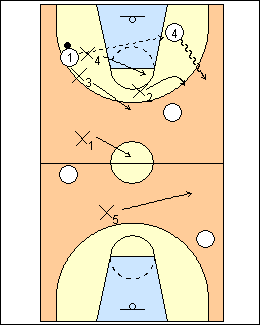 | 3 A benefit of ball reversal to the inbounder is that he could easily be one of the poorest ballhandlers, while the passer (here the point guard) is probably one of the better ones, and he is then denied a return pass. When the ball is reversed, point X4 sprints toward the middle. Wide wing X2 slides over the top to continue denying until X4 gets there to take over, then X2 closes out on the new ballhandler on an inside-out angle to encourage (fan) the dribble down the sideline. Tight wing X3 jumps to the ball and starts dropping toward the middle of the court to ball level. Monster X1 sprints to the middle but deeper than ball level. Safety X5 sprints toward the first potential pass receiver on the wide-side sideline to deny the quick pass. |
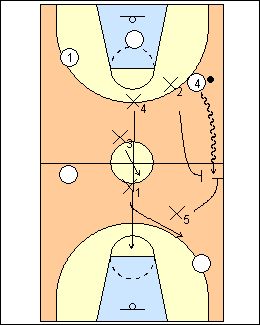 | 4 Safety X5 denies the man in his area and bluffs and retreats on the dribbler. As the ball crosses centre, X5 rotates up and traps with wide wing X2 (no lines, no splits). Monster X1 sprints through the middle and rotates to the attacker who appears to have been left open with X5 jump-trapping the dribbler with X2. Point X4 remains ballside of any attacker in the middle as he sprints to become the new protector of the basket. Tight wing X3 denies any pass to the middle of the court or deeper than ball-level. Trapping the ball over centre cuts the area that must be defended in half, with X4 the goalie, X1 denying the vertical pass up the sideline, and X3 denying the middle pass. If the opposition can escape with a pass out of the trap, all five defenders should sprint immediately into the half-court defence. |
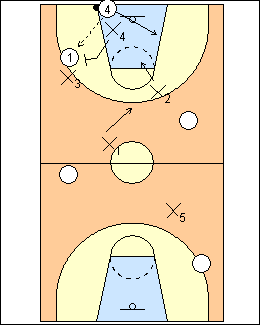 | 5 Pinch Stunt As before, X3 and X4 trap on the inbounds pass to the tight side. As previously mentioned, X1 and X2 must adequately defend three areas. In the "Pinch" stunt, two areas are taken away and the offence must correctly guess which area is open and then make the pass out of the trap. The middle pass is still denied but by monster X1, not wide wing X2. The usual safe reversal pass from O1 to O4 is made to appear to be open while X2 waits and looks to shoot the gap and make the interception. X5 maintains a cautious position to protect the basket. As before, if any passes or dribbles out of the initial trap are successful all defenders behind the ball must sprint to the level of the ball while any defenders that are still ahead of the level of the ball must cautiously contain the dribbler (other than the safety). |
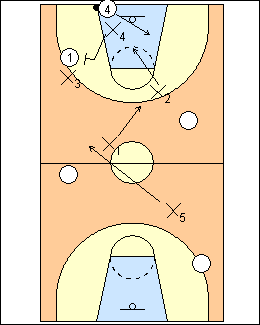 | 6 Swarm Stunt A much more aggressive and gambling stunt than "Pinch". Wide wing X2 again overplays the reversal pass and monster X1 again overplays the pass to the middle of the court. But in the "Swarm," safety X5 steps up to shoot the gap on the first pass receiver on the original tight side of the court. This leaves an open pass receiver, but it is the one who is the farthest from the original trap. With a great deal of pressure on the ball and added pressure on the three pass receivers nearest the ball, the defence may calculate that the distant receiver will not be seen or that the pass cannot be successfully made. If by chance the pass is made, all five defenders must sprint to get to ball level immediately. |
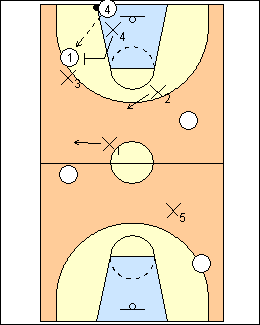 | 7 Match Stunt Can only be utilized when point X4 is an equal or has a defensive advantage over the pass receiver taking the reversal pass. On the trap by X4 and X3 on the tight side, monster X1 and wide wing X2 take away the middle and near sideline pass outlets, as they do in the regular 1-2-1-1. |
 | 8 If the ball is reversed, point X4 follows the pass and chases down the ball. All five defenders then match up with the closest man in their immediate area and play full-court man-to-man defence until the ball is turned over or nears the front court hash marks, where the half-court defence goes into effect. This is a very safe stunt with aggressive defensive pressure - a trap and possibly a mismatch on the opponent's worst ballhandler. The 1-2-1-1 press offers a forceful and aggressive defensive attack that can use any or all of the above stunts to wear down the opposition physically and mentally. It can be used from the beginning of the game to the end, not just as a last ditch effort to come from behind to win a game. |
This page was made with Basketball playbook from Jes-Soft